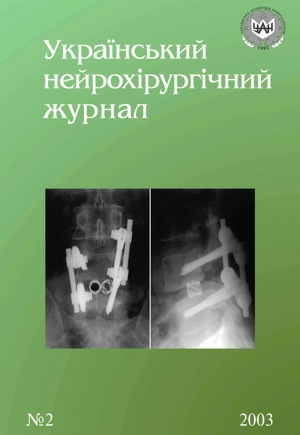Operative treatment of a lumbar spondylolisthesis with neurologic signs
Keywords:
spondylolisthesis, compression of the nerve roots, interbody fusion, transpedicular stabilization of the spineAbstract
We carry out inspection, surgical treatment and study of results of treatment 31 patients suffering from spondylolisthesis with neurologic signs. At all types of a spondylolisthesis were made decompression of neural roots and dural bag: at a spondylolisthesis I degree a redressation and stabilization were not carried out; at a spondylolisthesis II degrees we carried out a redressation and stabilized vertebras with cages, installed from back access (PLIF – posterior lumbar interbody fusion). The spondylolisthesis of the large degree (III–IV) was stabilized by installation cages from back access (PLIF) in a combination to installation transpedicular system. At all patients it was possible to achieve a reduction of a spondylolisthesis as a minimum on 1 degree, stabilization displaced vertebras. In overwhelming majority of cases achieve functional regress of a neurologic symptomatology.
The remote results were traced on 2–16 months at 14 patients: on the data Ro, CT and МRI at all patients the bone fusion achieved, progressing of a spondylolisthesis it was not marked. The patients with isthmic and dysplastic spondylolisthesis had stable neurologic condition. At 2 patients with a degenerative spondylolisthesis the relapse of a pain set of symptoms however less expressed on intensity took place than before operation.
References
Barbanti Brodano G., Donati U., Palmisani M., Pompili M., Boriani S. Posterior lumbar interbody fusion a mid-term review of 60 cases // Chir. Organi Mov. — 2000. — №85(4). — P.345—360.
Chang J.H., Lee C.H., Wu S.S., Lin L.C. Management of multiple level spondylolysis of the lumbar spine in young males: a report of six cases // J. Formos. Med. Assoc. —2001. —№100(7). —P.497—502.
Dai L.Y., Jia L.S., Yuan W., Ni B., Zhu H.B. Direct repair of defect in lumbar spondylolysis and mild isthmic spondylolisthesis by bone grafting, with or without facet joint fusion // Europ. Spine J. —2001. —№10(1). —P.78—83.
Goutallier D., Djian P., Borgese M.A., Allain J. Degenerative lumbar spondylolisthesis treated with isolated intersomatic arthrodesis: results of 30 cases with an average 4-year follow up // Rev. Chir. Orthop. Reparatrice. — Appar, Mot. — 2001.
Hollenberg G.M., Beattie P.F., Meyers S.P., Weinberg E.P., Adams M.J. Stress reactions of the lumbar pars interarticularis: the development of a new MRI classification system // Spine. — 2002. — №15;27(2). — P.181—186.
Ivanic G.M., Pink T.P., Achatz W., Ward J.C., Homann N.C., May M. Direct. Stabilization of Lumbar Spondylolysis With a Hook Screw: Mean 11-Year Follow-up Period for 113 Patients // Spine. — 2003. — №1;28(3). —P.255—259.
Pellise F., Toribio J., Rivas A., Garcia–Gontecha C., Bago J., Villanueva C. Clinical and CT scan evaluation after direct defect repair in spondylolysis using segmental pedicular screw hook fixation // J. Spinal Disord. — 1999. —№12(5). —P.363—367.
Pfeil J. Spinal growth under physiological and pathological conditions //Orthopade. — 2002. — №31(1). —P.2—10.
Prasartritha T. Surgical repair of pars defects in spondylolysis //J. Med. Assoc. Thai. —2001. —№84(9). — P.1235—1240.
StoneA.T., Tribus C.B. Acute progression of spondylolysis to isthmic spondylolisthesis in an adult // Spine. — 2002. — №15;27(16). — P.370—372.
Tan J., Jia L., Xu J., Zhou X., Lu H., Zuo J., Yuan W. Bone graft repair of adolescence spondylolysis with lag screw and tension band fixation //Zhonghua Wai Ke Za Zhi.— 2002. — №40(10). — P.727—729.
Theiss S.M. Isthmic spondylolisthesis and spondylolysis //J. South Orthop. Assoc. — 2001. — №10(3). — P.164—172.
Van der Wall H., Storey G., Magnussen J., Frater C.J., Pattinson R., Pereira J., Stephen J. Distinguishing scintigraphic features of spondylolysis //J. Pediatr. Orthop. — 2002. —№22(3). —P.308—311.
Zhang H., Jin A.M., Zhang M.C. Finite element analysis of shape memory alloy intrasegmental fixator for lumbar spondylolysis //Di Yi Jun Yi Da Xue Xue Bao. — 2002.
Downloads
How to Cite
Issue
Section
License
Copyright (c) 2003 E. I. Slinko, V. V. Verbov, A. I. Pastushin, A. V. Muravsky, M. E. Tsymbal, I. I. Al-Qashqish

This work is licensed under a Creative Commons Attribution 4.0 International License.
Ukrainian Neurosurgical Journal abides by the CREATIVE COMMONS copyright rights and permissions for open access journals.
Authors, who are published in this Journal, agree to the following conditions:
1. The authors reserve the right to authorship of the work and pass the first publication right of this work to the Journal under the terms of Creative Commons Attribution License, which allows others to freely distribute the published research with the obligatory reference to the authors of the original work and the first publication of the work in this Journal.
2. The authors have the right to conclude separate supplement agreements that relate to non-exclusive work distribution in the form of which it has been published by the Journal (for example, to upload the work to the online storage of the Journal or publish it as part of a monograph), provided that the reference to the first publication of the work in this Journal is included.









